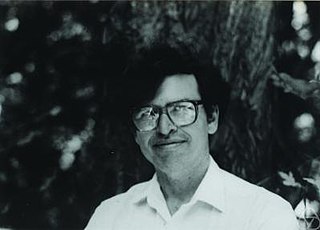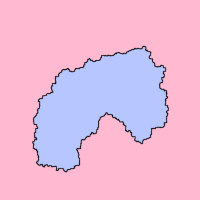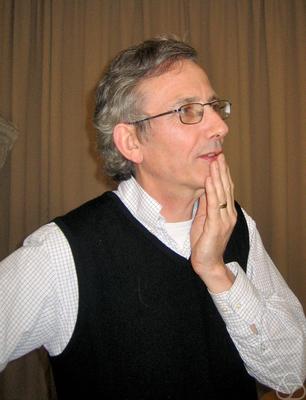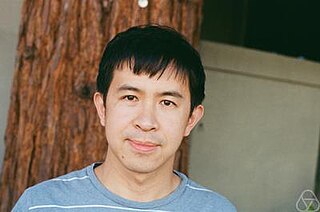Related Research Articles

William Paul Thurston was an American mathematician. He was a pioneer in the field of low-dimensional topology and was awarded the Fields Medal in 1982 for his contributions to the study of 3-manifolds.

In topology, the Jordan curve theorem, formulated by Camille Jordan in 1887, asserts that every Jordan curve divides the plane into an "interior" region bounded by the curve and an "exterior" region containing all of the nearby and far away exterior points. Every continuous path connecting a point of one region to a point of the other intersects with the curve somewhere. While the theorem seems intuitively obvious, it takes some ingenuity to prove it by elementary means. "Although the JCT is one of the best known topological theorems, there are many, even among professional mathematicians, who have never read a proof of it.". More transparent proofs rely on the mathematical machinery of algebraic topology, and these lead to generalizations to higher-dimensional spaces.

In mathematics, a knot is an embedding of the circle into three-dimensional Euclidean space, R3. Often two knots are considered equivalent if they are ambient isotopic, that is, if there exists a continuous deformation of R3 which takes one knot to the other.

John Henry Constantine Whitehead FRS, known as "Henry", was a British mathematician and was one of the founders of homotopy theory. He was born in Chennai, in India, and died in Princeton, New Jersey, in 1960.

In mathematics, geometric topology is the study of manifolds and maps between them, particularly embeddings of one manifold into another.

Oswald Veblen was an American mathematician, geometer and topologist, whose work found application in atomic physics and the theory of relativity. He proved the Jordan curve theorem in 1905; while this was long considered the first rigorous proof of the theorem, many now also consider Camille Jordan's original proof rigorous.
R. H. Bing was an American mathematician who worked mainly in the areas of geometric topology and continuum theory. His father was named Rupert Henry, but Bing's mother thought that "Rupert Henry" was too British for Texas. She compromised by abbreviating it to R. H. Consequently, R. H. does not stand for a first or middle name.

Sir Simon Kirwan Donaldson is an English mathematician known for his work on the topology of smooth (differentiable) four-dimensional manifolds, Donaldson–Thomas theory, and his contributions to Kähler geometry. He is currently a permanent member of the Simons Center for Geometry and Physics at Stony Brook University in New York, and a Professor in Pure Mathematics at Imperial College London.

Robion Cromwell Kirby is a Professor of Mathematics at the University of California, Berkeley who specializes in low-dimensional topology. Together with Laurent C. Siebenmann he developed the Kirby–Siebenmann invariant for classifying the piecewise linear structures on a topological manifold. He also proved the fundamental result on the Kirby calculus, a method for describing 3-manifolds and smooth 4-manifolds by surgery on framed links. Along with his significant mathematical contributions, he has over 50 doctoral students and is the editor of an influential problem list.

Andrew John Casson FRS is a mathematician, studying geometric topology. Casson is the Philip Schuyler Beebe Professor of Mathematics at Yale University.
The Oswald Veblen Prize in Geometry is an award granted by the American Mathematical Society for notable research in geometry or topology. It was funded in 1961 in memory of Oswald Veblen and first issued in 1964. The Veblen Prize is now worth US$5000, and is awarded every three years.

Jeff Cheeger is an American mathematician and Silver Professor at the Courant Institute of Mathematical Sciences of New York University. His main interest is differential geometry and its connections with topology and analysis.

Dennis Parnell Sullivan is an American mathematician known for his work in algebraic topology, geometric topology, and dynamical systems. He holds the Albert Einstein Chair at the Graduate Center of the City University of New York and is a distinguished professor at Stony Brook University.

Tomasz Mrowka is an American mathematician specializing in differential geometry and gauge theory. He is the Singer Professor of Mathematics and former head of the Department of Mathematics at the Massachusetts Institute of Technology.

Michael Jerome Hopkins is an American mathematician known for work in algebraic topology.

Barry Charles Mazur is an American mathematician and the Gerhard Gade University Professor at Harvard University. His contributions to mathematics include his contributions to Wiles's proof of Fermat's Last Theorem in number theory, Mazur's torsion theorem in arithmetic geometry, the Mazur swindle in geometric topology, and the Mazur manifold in differential topology.
In mathematics, the Schoenflies problem or Schoenflies theorem, of geometric topology is a sharpening of the Jordan curve theorem by Arthur Schoenflies. For Jordan curves in the plane it is often referred to as the Jordan–Schoenflies theorem.
Tobias Holck Colding is a Danish mathematician working on geometric analysis, and low-dimensional topology. He is the great grandchild of Ludwig August Colding.

Ian Agol is an American mathematician who deals primarily with the topology of three-dimensional manifolds.

Song Sun is a Chinese mathematician whose research concerns geometry and topology. A Sloan Research Fellow, he has been a professor in the Department of Mathematics of the University of California, Berkeley since 2018. In 2019, he was awarded the Oswald Veblen Prize in Geometry.
References
- ↑ "Oswald Veblen Prize in Geometry".
- ↑ Brown, Morton (1960). "A proof of the generalized Schoenflies theorem". Bull. Amer. Math. Soc. 66 (2): 74–76. doi: 10.1090/s0002-9904-1960-10400-4 . MR 0117695
- ↑ List of Fellows of the American Mathematical Society, retrieved 2012-11-10.